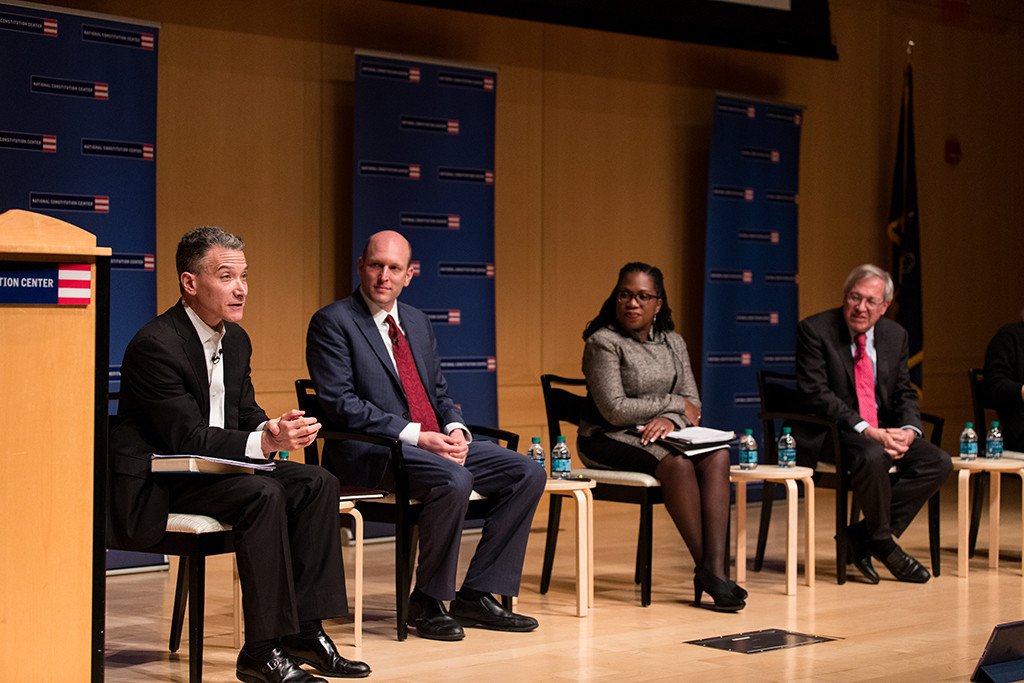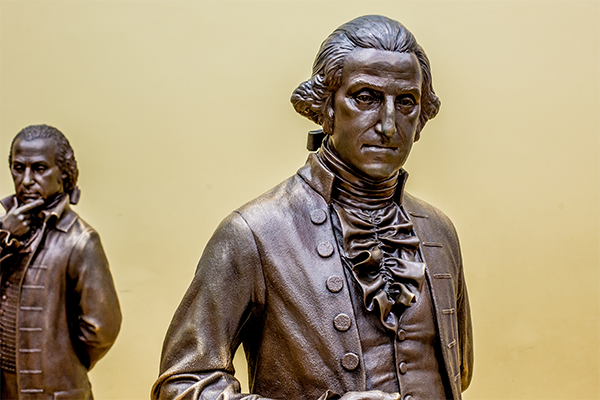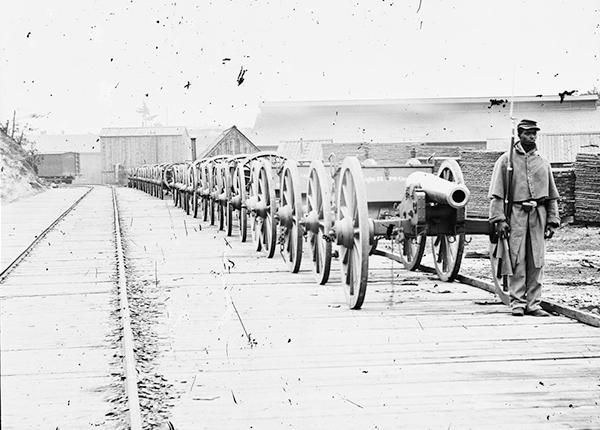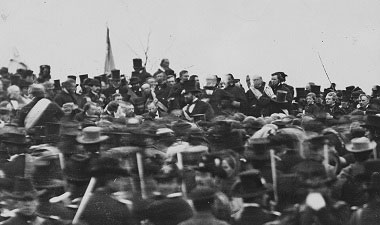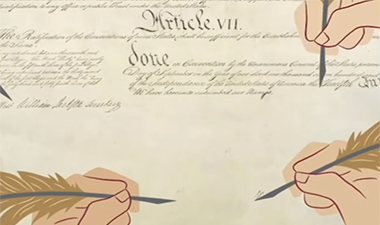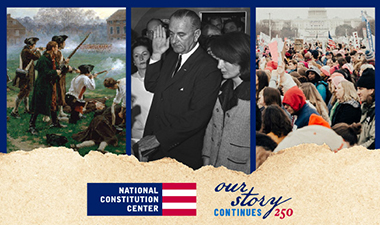
By Eric Slauter Deputy Dean of Arts and Humanities and the College, University of Chicago.
Eric Slauter notes that the Declaration’s stirring words are a testament to the power of ideas and to the efforts of ordinary Americans to press them into service for change.
The Declaration of Independence is a document of its time, an empire-shattering manifesto written by a small group of revolutionary authors and broadcast to the world in 1776. But the Declaration we now celebrate is also a product of generations of motivated readers across history who transformed an instrument designed to announce the sovereignty of the United States of America and its secession from the British Empire into a founding charter of liberty, equality, and rights.
For many today, the Declaration’s meaning is captured in these stirring words: “We hold these Truths to be self-evident, that all Men are created equal, that they are endowed by their Creator with certain unalienable Rights, that among these are Life, Liberty, and the Pursuit of Happiness.” This sentence, finalized by Congress and first set in type on July 4, 1776, is now justly recognized as one of the most important sentences in American history. But few at the time, including Thomas Jefferson, John Adams, and Benjamin Franklin and their colleagues in Congress, would have identified these words as among the most important in the document. The story of how these self-evident truths transcended their original moment is a testament both to the power of those ideas and to the efforts of ordinary Americans to press them into service for change.
Words and sentences by themselves do not make history. They need active readers to absorb, animate, and apply them. This now-famous sentence has had admirers since the founding period and over time it became a crucial touchstone for individuals and groups seeking to expand liberty and equality. In 1794, as some celebrated the exportation of American ideals to revolutionary France, Sam Adams may have become the first signer of the Declaration to discover a “doctrine of liberty and equality” in the Declaration’s assertion that “all men are created equal” and “endowed by their Creator with certain unalienable rights.” A Jeffersonian Republican surrounded in Massachusetts by Federalists, he saw this doctrine as a central article in what he termed, borrowing a word more associated with religion than politics, “the political creed of the United States.”
From the Civil War to Civil Rights, speakers and writers have deployed the self-evident truths to shape how Americans understand the meaning of the nation’s founding principles and to highlight what they have seen as the promises the revolutionary generation made to its posterity. On the way to his inauguration in 1861, President-elect Abraham Lincoln stopped at Independence Hall in Philadelphia, the location where both the Declaration and the Constitution were drafted, and made an impromptu speech in which he told the crowd that he had “never had a feeling politically that did not spring from the sentiments embodied in the Declaration of Independence,” noting that those words “gave promise in due time that the weight would be lifted from the shoulders of all men.” More famously, President Lincoln quoted the words in his 1863 Gettysburg Address, asserting that the nation itself had been “conceived in liberty and dedicated to the proposition that all men are created equal.”
In 1963, with the Lincoln Memorial behind him, Reverend Martin Luther King Jr. marked the centennial of the Emancipation Proclamation by describing these words as a “promissory note” due to all Americans. “This note,” King explained, “was a promise that all men — yes, Black men as well as white men — would be guaranteed the unalienable rights of life, liberty and the pursuit of happiness.” “I have a dream,” King told his audience at the March on Washington in what remains the best-known invocation of the Declaration from the twentieth century, “that one day this nation will rise up and live out the true meaning of its creed: We hold these truths to be self-evident, that all men are created equal.”
Few in 1776 could have predicted the power these words would have across time. Indeed, in 1776, this was not the most important sentence in the document, at least to its authors and most readers.
These self-evident truths were merely the philosophical premises that helped establish the far more relevant “Right of the People” to alter or abolish a government that failed to secure unalienable rights. For most of the Declaration’s authors and audiences in 1776 even that premise, the right of revolution, would have been less meaningful than the words that followed.
When Americans saw the Declaration posted in public places or encountered the text in the pages of newspapers their eyes were drawn away from these abstract “truths” to the long list of concrete “facts” presented against the King in the middle of the document. Here was the true justification for separation. Many others in the former colonies, listening to those words proclaimed by military or civilian leaders, must have strained to hear and even cheer each new indictment of their former King for his “tyranny”—a word so dangerous that British publishers sometimes refused to print it for fear of being charged with seditious libel. “The history of the present ---- of Great Britain,” readers of London’s Gentleman’s Magazine learned in August 1776, “is a history of repeated injuries and usurpations; all having in direct object the establishment of an absolute t------ over these states.”
As electrifying and divisive as these words were, members of Congress in 1776 and most of their audience could easily pick out the most consequential words in the Declaration: they were the words that members of Congress had approved on July 2. When it came time for the first printer, Irish-born John Dunlap, to set them in type on July 4, he deployed all-caps for the most-important words in the most-important sentence: “That these United Colonies are, and of Right ought to be, FREE AND INDEPENDENT STATES; that they are absolved from all Allegiance to the British Crown, and that all political Connection between them and the State of Great-Britain, is and ought to be totally dissolved.” Across July, every printer followed Dunlap’s lead. In early August, when scribe Timothy Matlack wrote the Declaration out on a piece of parchment, he elected to shift the style of his handwriting from a “Round” cursive hand to render the words “Free and Independent States” in a contrasting Gothic script, one of the few parts of that manuscript that remains legible to visitors to the National Archives today. This was, after all, the real declaration of independence.
How did the Declaration’s premises become its promises? If readers in 1776 could easily identify the key sentence, how did the self-evident truths of the Declaration come to eclipse the official resolution? How did phrases such as “all Men are created equal” or “Life, Liberty, and the Pursuit of Happiness” replace “FREE AND INDEPENDENT STATES” in our understanding of the meaning of the document? The story is a multigenerational one, but it too begins in 1776.
The reality of slavery was nearly impossible for early readers of the Declaration to ignore as they encountered the document’s rhetorical fireworks in newspapers. On the evening of July 2, 1776, the first report that Congress had voted on a resolution for independence and that the colonies were now “FREE and INDEPENDENT STATES” sat side-by-side in a Philadelphia newspaper with a notice offering a reward for the capture of a 25-year-old Black man named Ishmael, a fugitive who had fled from his would-be owner. From July 6 through August 2, 1776, the Declaration was printed in over thirty newspapers across the new states. In nearly two-thirds of those newspapers the words of the Declaration sat near advertisements for the return of other men who had emancipated themselves. Readers of the Declaration in the New York Journal on July 11, 1776, had only to turn the text of the Declaration over to learn about rewards for the return of Jack, Samson, and Prince, Black men who had freed themselves from the bonds of slavery.
Does the Declaration mean what it says? Could the delegates to Congress who declared the colonies to be “FREE AND INDEPENDNT STATES” have truly believed that “all Men are created equal, that they are endowed by their Creator with certain unalienable Rights,” including “Life, Liberty, and the Pursuit of Happiness”? If all were truly created equal, then how did John Hancock and his colleagues explain the presence of inequalities of all kinds in the new United States of America? And if liberty was a right that could never be surrendered, then why did so many men, women, and children live in slavery? Did Congress purposefully mean to exclude those people? Did they perhaps intend to emancipate them? Or were the men who declared these truths simply hypocrites?
These questions are not new or the product of twenty-first century presumptions. They were all asked in 1776 and have been a part of the Declaration’s reception since the very beginning.
A few critics, both American Loyalists and British writers, posed these questions to discredit the authors of the Declaration and puncture what they took to be the high-sounding pretensions of Congress’s arguments. A writer in a London newspaper in September 1776 described the Declaration’s philosophy as utter “nonsense.” Did the authors even know what the word “unalienable” meant? After all, slavery existed in America and “where there are Slaves, Liberty is alienated.”
Thomas Hutchinson, the former governor of Massachusetts who lived as a refugee in London, took it a step further when he provided an analysis of the Declaration for the Prime Minister of Great Britain in October 1776. Hutchinson told Lord North that if such statements as “all men are created equal” were “truths” then he had a pointed question he wished to ask the congressional delegations from Maryland, Virginia, and the Carolinas: How could “their Constituents justify the depriving more than an hundred thousand Africans [of] their rights to liberty, and the pursuit of happiness, and in some degree to their lives, if these rights are so absolutely unalienable”? Hutchinson’s question continues to echo across time, resonating with modern readers who may know that his count fell far short of the number of enslaved people in southern states and diminished the presence of enslaved people in northern states, including in his former home of Massachusetts. Historians now estimate that half a million people, one fifth of the population of the new United States, lived in slavery in 1776.
By the time the former Loyalist governor raised his provocative question, a small number of inhabitants in the new nation had already asked similar questions, but with hope rather than sarcasm: Could the Declaration of Independence truly mean what it said? And if so, then what were the consequences of those self-evident truths? What did the Declaration’s words promise the enslaved?
Reverend William Gordon of Roxbury, Massachusetts, may have been the first to pose these questions in print in the United States, in a Boston newspaper on October 3, 1776, two weeks before Hutchinson published his attack on the Declaration in London. Gordon had served as a chaplain to the Massachusetts legislature. He explained in an open letter to those men who were now preparing to frame a new constitution for the state of Massachusetts that he had been reading the Declaration of Rights from Virginia, with its claim that all men were born equally “free and independent,” along with the Declaration of Independence. Perhaps some readers had glossed over the self-evident truths in July, but Gordon wanted them to re-read the Declaration now and he wanted readers to hear the words differently.
An obliging typesetter used italic letters to help Gordon emphasize those words in a way no other newspaper had done when the Declaration first circulated in July and August. “The Congress declare,” Gordon observed, “that they ‘hold these truths to be self-evident, that all men are created equal, that they are endowed by their Creator with certain unalienable rights, that among these are life, liberty and the pursuit of happiness.” Were these, Gordon asked, “our genuine sentiments”? Or was Congress “provoking the Deity, by acting hypocritically to serve a turn?” Gordon hoped Congress meant what it said. And if it did, then these truths must be acted upon in accordance with their most obvious plain meaning: “let us apply,” Gordon told the legislators in Massachusetts, “earnestly and heartily to the extirpation of slavery from among ourselves.” Gordon seems to be the first to put these thoughts into print, but this white minister’s understanding of the same words had almost certainly been anticipated by others with antislavery sentiments in the days, weeks, and months following the publication of the Declaration.
Indeed, on the opening page of an extraordinary manuscript rediscovered and first printed over two hundred years after it was composed, a young soldier and future minister of mixed racial ancestry named Lemuel Haynes may well have been the very first writer ever to quote what became the Declaration of Independence’s most famous phrase. Haynes had a Black father and a white mother. He had been abandoned shortly after his birth in 1753 and was raised in Middle Granville, Massachusetts. He had experienced life as an indentured servant and a farm laborer, but he had never been a slave. In the wake of the battles of Lexington and Concord in April 1775, he had marched with the minutemen of his town to protect Boston; in 1776, he joined the Continental Army. At some time, likely before July 4, 1776, he drafted an anti-slavery tract, compelled in part by similar pamphlets and newspaper essays he had read and would cite in his own original work.
Haynes called that work “Liberty Further Extended,” a nod to the connection he would draw between the political condition of the colonies to Britain and the personal condition of enslaved Black people. Haynes deployed the increasingly common language of natural rights alongside his intensive reading of the Bible. Although we do not know the exact date that Haynes put pen to paper, internal clues in his manuscript—references to the “colonys” rather than the “states”—suggest he had been working on his pamphlet when the news of independence and the Declaration arrived. Even the title suggested the turning point, that a moment of “FREE AND INDEPENDENT STATES” might also be a moment to extend liberty further. He prepared a manuscript title-page for his work and these are the words Haynes selected as an epigraph: “We hold these truths to Be self-Evident, that all men are created Equal, that they are Endowed By their Creator with certain unalienable rights, that among these are Life, Liberty, and the pursuit of happyness.” He attributed the words to Congress. Like most readers, he would have had little chance of knowing who precisely had written them.
Reverend Gordon and Private Haynes saw promises in the Declaration of Independence and their voices started a process that helped to elevate the self-evident truths to a central place in our understanding of the Declaration. They were soon joined by others, a chorus of religious voices in different states. By 1777, in an antislavery address directed to Congress, the Connecticut minister Isaac Foster told delegates that the self-evident truths that few readers had paused over in 1776 “deserve to be written in letters of gold.” (His own words survive in a single, tattered copy of his printed pamphlet.) In 1778, Jacob Green, a minister from New Jersey asked listeners and later readers “’if ‘tis self-evident, i.e. so clear that it needs not proof, how unjust, how inhuman, for Britons, or Americans, not only to attempt, but actually to violate this right?” That same year, a Quaker from Pennsylvania named Anthony Benezet suggested that a nation that made the solemn public declarations of equality and liberty in the Declaration before God while simultaneously supporting slavery risked divine punishment for hypocrisy. As war turned to peace in 1783, another minister, David Cooper of New Jersey, published an address to “the Rulers of America” in Congress on the inconsistency of slavery in a land committed to liberty. Could the Congress of 1776, he asked, have truly meant only “the rights of whitemen” and not “all men”?
Most citations of the phrase “all Men are created equal” in newspapers, books, and pamphlets in the first fifteen years after 1776 came from opponents to slavery. Formal abolition societies in Pennsylvania in 1788, in Maryland in 1791, and New Jersey in 1793 all deployed that phrase. Abolitionists in Congress invoked the self-evident truths on the floor of the new House of Representatives in 1790s, even though the Constitution itself denied Congress the power to prohibit the migration and importation of enslaved people before 1808. By 1792, when the almanac maker Benjamin Banneker quoted the “true and invaluable doctrine… ‘that all men are created equal’’’ back to Secretary of State Thomas Jefferson in an exchange of letters reprinted across the new nation, abolitionists had been working for a decade and a half to make Americans identify their Declaration with the cause of enslaved peoples.
And by the fiftieth anniversary in 1826, it was not just abolitionists who were invoking the self-evident truths as the founding ideas of the nation. By 1819, a fancy engraving of the Declaration marketed by the Democratic Republican editor John Binns would highlight the first self-evident truth, converting the words John Dunlap had first printed as “all Men are created equal” to “ALL MEN ARE CREATED EQUAL.” The words spread, inspiring groups of men and women to draft declarations of their own. Workingmen called for greater protections of the inalienable rights of workers in the 1820s. More famously, advocates for women’s rights in Seneca Falls in 1848 declared that “all men and women are created equal.”
On the eve of the Civil War, many free Americans seemed to agree on the growing centrality of the self-evident truths, some for better and some for worse. In 1848, the proslavery South Carolina Senator John C. Calhoun described the claim of equality in the Declaration as a politically unnecessary “error.” After all, Calhoun reasoned, independence could have been announced without this “false and dangerous” idea, which “lay dormant” for many years but was now germinating and beginning to produce “poisonous fruits.”
In the wake of the Dred Scott decision in 1857, Abraham Lincoln also acknowledged that the claim that all men are created equal was “of no practical use” in dissolving ties with Britain. Instead, he said it had been put there “for future use.” Lincoln quoted the Declaration’s truths increasingly in the following years, incorporating them into the Gettysburg Address in 1863. After his assassination, as the Thirteenth Amendment abolishing slavery worked its way through state legislatures in 1865, Senator Charles Sumner delivered a eulogy for his fallen leader under the title “The Promises of the Declaration of Independence.”
Frederick Douglass, the former slave and prominent abolitionist, agreed about the significance of the self-evident truths, but saw things differently: America, he said in 1852, was “false to the past,” and its current conduct was at odds with the revolutionary heritage embodied in the Declaration. To an enslaved person’s ears, Douglass explained, the “shouts of liberty and equality” that routinely accompanied celebrations of the Declaration were nothing but “hollow mockery.”
By the time Southern states began seceding from the Union, issuing declarations of secession and independence rooted in the Declaration of the Continental Congress, many more Americans had taken the interpretive turn that Calhoun dreaded, that Lincoln longed for, and that Douglass found hypocritical. In doing so, they had discovered in the Declaration’s second paragraph a radical commitment to equality and rights that most of its framers and early readers could not have anticipated.
In the 250 years since the Declaration was first printed and signed, the claims of equality and rights in the second paragraph have come to be seen as a major contribution to world politics, imported sometimes wholesale into documents such as the declarations of other nation-states or the Universal Declaration of Human Rights of the United Nations. The French Declaration of the Rights of Man and Citizen of 1789, drafted while Thomas Jefferson was in Paris, was the first to follow in the Declaration’s wake. It began with the claim that men are born free and remain equal in rights.
By 1789, when French leaders drew on American documents to craft their own statements about rights and equality, a rhetorical sea change had occurred in the United States. The ubiquitous revolutionary conception that all men are created equal did not find its way into the Constitution of the United States, despite the fact that the constitutions of several states began with statements that “all men are by nature equally free and independent” (Virginia), that “all men are born equally free and independent” (Pennsylvania, Vermont, New Hampshire), and that “all men are born free and equal” (Massachusetts). The seeming neglect of the first Congress to domesticate the Declaration by amendment in 1789 may have had as much to do with the rhetoric of antislavery as with the reality of slavery. For, by 1789, antislavery writers had effectively captured the meaning of the second paragraph of the Declaration. They saw a promise of liberty in it that its authors may not have acknowledged.
But at the time, very few in the newly United States besides a small contingent of Black and white antislavery activists would have seen the Declaration as a document of radical egalitarianism or even as a founding document. That we do so now is a testament in part to their efforts, and to generations of readers since who have pressed the United States to live up to those words. They saw promises in the Declaration, and it is largely their Declaration, as much as Jefferson’s or Congress’s, that we continue to celebrate today.
Eric Slauter is Deputy Dean of the Arts and Humanities and the College and Director of the Karla Scherer Center for the Study of American Culture at the University of Chicago. This essay is adapted from Slauter’s forthcoming book, The Promises of the Declaration.


